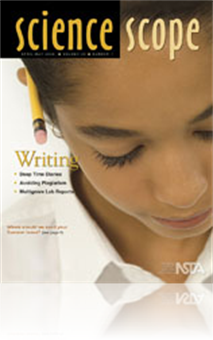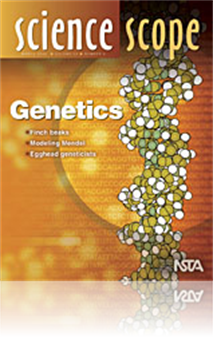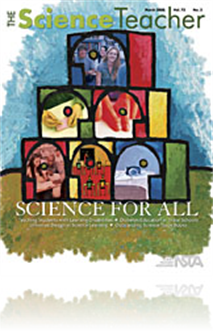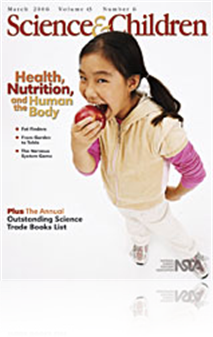All Resources
Journal Article
Scope on Safety: MSDS--What's it all about?
OSHA's Hazard Communication Standard (HazCom) requires chemical manufactures to provide material safety data sheets (MSDS) for hazardous chemicals. This column will help science teachers, supervisors, and administrators better understand what is requ...
Journal Article
Do you believe that science trade books can spark real-life involvement in saving a threatened fish? A successful science program at Westbrook Elementary School, in Bethesda, Maryland in which students participate in watershed restoration shows just...
Journal Article
Science Shorts: Inquiring About Isopods
Isopods, which include favorite backyard critters otherwise known as pill bugs or roly-polies, are intriguing in more ways than one. Not only do isopods easily promote inquiry and help reduce "bug" phobia among students, they also have the distinct ...
Journal Article
What breathes and eats in water, dramatically clamps down on students' pencils, carries eggs that hatch to produce many offspring, excites students tremendously, does not die easily and stinks up a classroom, and--most importantly--is able to teach s...
Journal Article
Whiteboarding Your Way to Great Student Discussions
Dry erase boards, sometimes called whiteboards, are a powerful tool for facilitating discussion within groups of students. When each group receives a large whiteboard and specific instructions about how to use the board to record their thinking, stud...
Journal Article
Learning Logs in the Science Classroom - The Literacy Advantage
One of the most functional forms of writing to learn is two-column learning logs. Two-column learning logs are based on the premise that collecting information and processing information are two very different aspects of learning. Middle school stude...
Journal Article
Multigenre Lab Reports: Connecting Literacy and Science
The development of communication skills is a key component in any science program but most students don't see the connection between science and writing. Connect literacy and science by using this hands-on activity that is a fun alternative to tradit...
Journal Article
Studying Hammerheads in Hawaii
The High School Scalloped Hammerhead Shark Tagging Program in Hawaii is an example of a successful partnership researach collaboration. As part of the program, high school students and teachers worked with biologists from the University of Hawaii-Man...
Journal Article
The inquiry science process provides a perfect opportunity for students to practice relational meaning in language. As students design their experiments, negotiate their ideas with peers, and share their data and conclusions, they sharpen both their ...
Journal Article
Studying Caenorhabditis elegans (C. elegans) live cultures provides excellent opportunities for authentic inquiry in a high school anatomy and physiology or other biology lab course. The anatomy of C. elegans, a free-living roundworm found in soil ...
Journal Article
Teaching Through Trade Books: Wonderful, Wiggly Worms
Worms have the ability to either elicit screams of excitement or perhaps screams period. Although we don't generally see them, worms are an important part of our world. Take this opportunity to introduce students to the importance worms serve in a...
Journal Article
Every Day Science Calendar: April 2006
This monthly feature contains facts and challenges for the science explorer. ...
Journal Article
Tried and True: Peanut butter and jelly science
Are you feeling frustrated with the quality of your students' writing or lack there of? If so, head straight for the peanut butter and jelly. Students will respond to this fun filled activity as they learn the importance of writing clear procedures i...
Journal Article
A collaborating scientist—a rewarding addition to any high school science program—can help students collect and analyze data that either replicates or parallels the work of the partnering scientist. A perfect example of a scientist-student collab...
Journal Article
Editor's Note (April/May 2006)
Children's passion for animals is not surprising. Animals can calm and heal both children and adults. Critters--whether furry, cute, large, small, or even a little creepy--inspire and entertain us. Despite their recognized value, they are often ne...
Journal Article
Issues in-depth: Cloning: A critical analysis of myths and media
The science behind cloning, and its long history, provide teachers with a real-life, high interest topic through which they can launch an effort to raise students’ media literacy skills. By blending science content with critical thinking and reflec...
Journal Article
Science Sampler - Eggheads: Pioneers of genetics
Today, scientific discoveries can feel anonymous to students. We take many breakthrough discoveries for granted. This timeline activity was created to renew the notion that individual actions make a difference in the progress of scientific thought. S...
Journal Article
Teaching Science to Students with Learning Disabilities
Due to increasingly widespread inclusion practices and more thorough identification procedures, students with documented learning disabilities (LD) are becoming a larger percentage of the science classroom. Because many practicing science teachers ha...
Journal Article
The Art & Science of Mask Making
Art, particularly observational drawing, plays an important role in science. By creating representational artwork, students develop observation skills and appreciation of the diverse ways organisms have adapted to life on Earth. This interdisciplinar...
Journal Article
Diabetes Education in Tribal Schools
American Indian/Alaska Native (AI/AN) populations are in the midst of a Type 2 diabetes epidemic. To address this crisis, the National Institute of Diabetes and Digestive and Kidney Diseases (NIDDK) began funding a national initiative titled "Diabete...
Journal Article
The sight of young children eagerly reaching for and eating string beans, carrots, lettuce, radishes, and even raw beets and onions is an incredibly satisfying one for a science teacher. The experience of growing food is a natural motivation for get...
Journal Article
Take a Tumble: Weathering and Erosion Using a Rock Tumbler
The subtle effects of weathering and erosion are difficult to convey to students. However, through this activity, students can use a rock tumbler to gain a personal and scientific perspective on weather and erosion. Students have the opportunity to d...
Journal Article
Science Sampler: Phasing in lunar observations
Increase students' understanding of the phases of the Moon through this interdisciplinary unit which includes a pre-test to gauge students' prior knowledge and a post-test to assess their increased understanding of the taught concepts upon completion...








